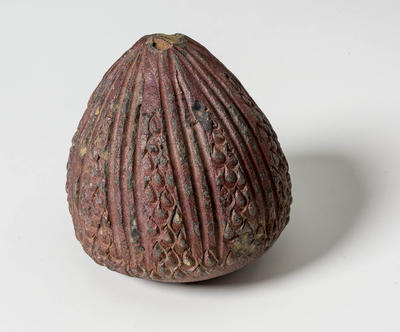Sphero-conical vessel
Production date
10th Century-11th Century
Country
Egypt
See full details
Object detail
Description
An incomplete Fatimid sphero-conical vessel, also called aeolipile. Fabric is mid brown with dark brown slip. Oval shaped, highly fired brown clay. The main body of the vessel is an ovoid, tapering to a rounded point at the base. Immediately below the undecorated shoulder is a repeating pattern consisting of several sets of three moulded lines, spaced around the vessel, set of a field of small impressed lozenges. The pointed base is broken. Central opening once held long neck made of wood or horn and covered in leather, which has since perished.
Classification
ARCHAEOLOGY
ARMS & ARMOUR
ARMS & ARMOUR
Production date
10th Century-11th Century
Production place
Measurements
L87mm x W66mm x D66mm
Media/Materials description
Clay
Glaze
Glaze
History and use
The function of these enigmatic objects, called sphero-conical vessels, and found from Egypt to central Asia during the later Islamic Period, are the subject of much debate. Some experts think these are ancient incendary devices, such as hand grenades or gunpowder flasks, containers for mercury, medicine or oils, fire blowers, others perfume bottles, holy water bottles, lamps or decorative finials in architecture. They are made from a highly fired ceramic that looks like stone, and they are often called stone ware. They are either plain or decorated with incisions and covered with a grey brown slip. These were made in different workshops. Some were made of metal or glass.
Associated person
Registration number
E921



